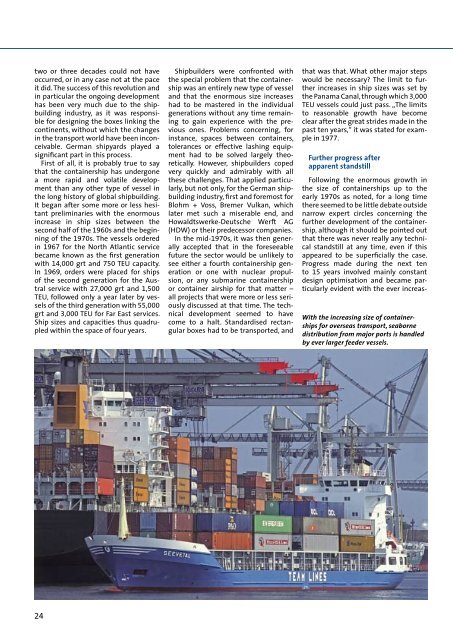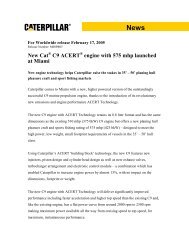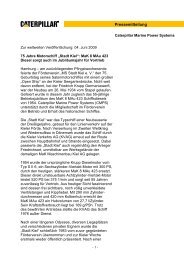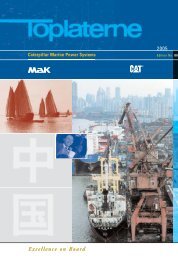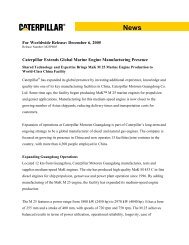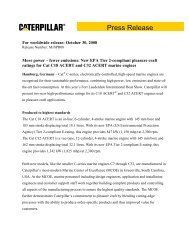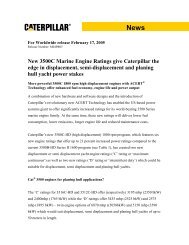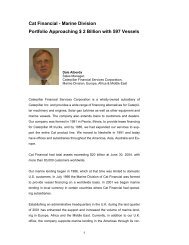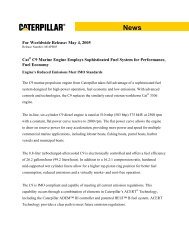Caterpillar Marine - Marine Engines Caterpillar
Caterpillar Marine - Marine Engines Caterpillar
Caterpillar Marine - Marine Engines Caterpillar
You also want an ePaper? Increase the reach of your titles
YUMPU automatically turns print PDFs into web optimized ePapers that Google loves.
two or three decades could not have<br />
occurred, or in any case not at the pace<br />
it did. The success of this revolution and<br />
in particular the ongoing development<br />
has been very much due to the shipbuilding<br />
industry, as it was responsible<br />
for designing the boxes linking the<br />
continents, without which the changes<br />
in the transport world have been inconceivable.<br />
German shipyards played a<br />
significant part in this process.<br />
First of all, it is probably true to say<br />
that the containership has undergone<br />
a more rapid and volatile development<br />
than any other type of vessel in<br />
the long history of global shipbuilding.<br />
It began after some more or less hesitant<br />
preliminaries with the enormous<br />
increase in ship sizes between the<br />
second half of the 1960s and the beginning<br />
of the 1970s. The vessels ordered<br />
in 1967 for the North Atlantic service<br />
became known as the first generation<br />
with 14,000 grt and 750 TEU capacity.<br />
In 1969, orders were placed for ships<br />
of the second generation for the Austral<br />
service with 27,000 grt and 1,500<br />
TEU, followed only a year later by vessels<br />
of the third generation with 55,000<br />
grt and 3,000 TEU for Far East services.<br />
Ship sizes and capacities thus quadrupled<br />
within the space of four years.<br />
24<br />
Shipbuilders were confronted with<br />
the special problem that the containership<br />
was an entirely new type of vessel<br />
and that the enormous size increases<br />
had to be mastered in the individual<br />
generations without any time remaining<br />
to gain experience with the previous<br />
ones. Problems concerning, for<br />
instance, spaces between containers,<br />
tolerances or effective lashing equipment<br />
had to be solved largely theoretically.<br />
However, shipbuilders coped<br />
very quickly and admirably with all<br />
these challenges. That applied particularly,<br />
but not only, for the German shipbuilding<br />
industry, first and foremost for<br />
Blohm + Voss, Bremer Vulkan, which<br />
later met such a miserable end, and<br />
Howaldtswerke-Deutsche Werft AG<br />
(HDW) or their predecessor companies.<br />
In the mid-1970s, it was then generally<br />
accepted that in the foreseeable<br />
future the sector would be unlikely to<br />
see either a fourth containership generation<br />
or one with nuclear propulsion,<br />
or any submarine containership<br />
or container airship for that matter –<br />
all projects that were more or less seriously<br />
discussed at that time. The technical<br />
development seemed to have<br />
come to a halt. Standardised rectangular<br />
boxes had to be transported, and<br />
that was that. What other major steps<br />
would be necessary? The limit to further<br />
increases in ship sizes was set by<br />
the Panama Canal, through which 3,000<br />
TEU vessels could just pass. „The limits<br />
to reasonable growth have become<br />
clear after the great strides made in the<br />
past ten years,“ it was stated for example<br />
in 1977.<br />
Further progress after<br />
apparent standstill<br />
Following the enormous growth in<br />
the size of containerships up to the<br />
early 1970s as noted, for a long time<br />
there seemed to be little debate outside<br />
narrow expert circles concerning the<br />
further development of the containership,<br />
although it should be pointed out<br />
that there was never really any technical<br />
standstill at any time, even if this<br />
appeared to be superficially the case.<br />
Progress made during the next ten<br />
to 15 years involved mainly constant<br />
design optimisation and became particularly<br />
evident with the ever increas-<br />
With the increasing size of containerships<br />
for overseas transport, seaborne<br />
distribution from major ports is handled<br />
by ever larger feeder vessels.


